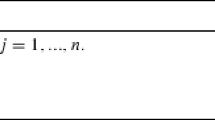Abstract
We consider a problem of scheduling n independent jobs on m unrelated parallel machines with the objective of minimizing total tardiness. Processing times of a job on different machines may be different on unrelated parallel-machine scheduling problems. We develop several dominance properties and lower bounds for the problem, and suggest a branch and bound algorithm using them. Results of computational experiments show that the suggested algorithm gives optimal solutions for problems with up to five machines and 20 jobs in a reasonable amount of CPU time.





Similar content being viewed by others
References
Alidaee B and Rosa D (1997). Scheduling parallel machines to minimize total weighted and unweighted tardiness. Comput Opns Res 24: 775–788.
Azizoglu M and Kirca O (1998). Tardiness minimization on parallel machines. Int J Prod Econom 55: 163–168.
Azizoglu M and Kirca O (1999). Scheduling jobs on unrelated parallel machines to minimize regular total cost function. IIE Trans 31: 153–159.
Cheng TCE and Chen ZL (1994). Parallel-machine scheduling problems with earliness and tardiness penalties. J Opl Res Soc 45: 685–695.
Dogramaci A and Surkis J (1979). Evaluation of a heuristic for scheduling independent jobs on parallel identical processors. Mngt Sci 25: 1208–1216.
Emmons H (1969). One-machine sequencing to minimize certain functions of job tardiness. Oprns Res 17: 701–715.
Gupta JND, Ruiz-Torres AJ and Webster S (2003). Minimizing maximum tardiness and number of tardy jobs on parallel machines subject to minimum flow-time. J Opl Res Soc 54: 1263–1274.
Ho JC and Chang YL (1991). Heuristics for minimizing mean tardiness for m parallel machines. Nav Res Log 38: 367–381.
Kim YD (1987). On the superiority of a backward approach in list scheduling algorithms for multi-machine makespan problems. Int J Prod Res 25: 1751–1759.
Kim YD (1995). A backward approach in list scheduling algorithms for multi-machine tardiness problems. Comput Opns Res 22: 307–319.
Ko HH, Baek JK, Kang YH and Kim SS (2004). A scheduling scheme for restricted parallel machines with cycling process. J Korean Inst Ind Eng 30: 107–119.
Kondakci S, Kirca O and Azizoglu M (1994). An efficient algorithm for the single machine tardiness problem. Int J Prod Econ 36: 213–219.
Koulamas CP (1997). Decomposition and hybrid simulated annealing heuristics for the parallel-machine total tardiness problem. Nav Res Log 44: 109–125.
Lee YH and Pinedo M (1997). Scheduling jobs on parallel machines with sequence-dependent setup times. Eur J Opl Res 100: 464–474.
Liaw CF, Lin YK, Cheng CY and Chen M (2003). Scheduling unrelated parallel machines to minimize total weighted tardiness. Comput Opns Res 30: 1777–1789.
Panwalkar SS, Smith ML and Koulamas CP (1993). A heuristic for the single machine tardiness problem. Eur J Opl Res 70: 304–310.
Park MW (2000). A genetic algorithm for the parallel-machine total weighted tardiness problem. J Korean Inst Ind Eng 26: 183–192.
Potts CN and Van Wassenhove LN (1985). A branch and bound algorithm for the total weighted tardiness problem. Opns Res 33: 363–377.
Rachamadugu RMV (1987). A note on the weighted tardiness problem. Opns Res 35: 450–452.
Vepsalainen A and Morton T (1987). Priority rules for job shops with weighted tardiness costs. Mngt Sci 33: 1035–1047.
Yalaoui F and Chu C (2002). Parallel machine scheduling to minimize total tardiness. Int J Prod Econom 76: 265–279.
Author information
Authors and Affiliations
Corresponding author
Rights and permissions
About this article
Cite this article
Shim, SO., Kim, YD. Minimizing total tardiness in an unrelated parallel-machine scheduling problem. J Oper Res Soc 58, 346–354 (2007). https://doi.org/10.1057/palgrave.jors.2602141
Received:
Accepted:
Published:
Issue Date:
DOI: https://doi.org/10.1057/palgrave.jors.2602141




